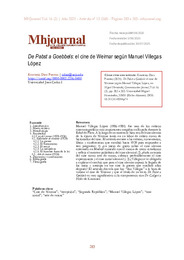Please use this identifier to cite or link to this item:
https://hdl.handle.net/11000/37376Full metadata record
| DC Field | Value | Language |
|---|---|---|
| dc.contributor.author | Diez-Puertas, Emeterio | - |
| dc.contributor.other | Departamentos de la UMH::Ciencias Sociales y Humanas | es_ES |
| dc.date.accessioned | 2025-09-12T11:52:48Z | - |
| dc.date.available | 2025-09-12T11:52:48Z | - |
| dc.date.created | 2025 | - |
| dc.identifier.citation | MHJournal Vol. 16 (2), Año 2025 -Artículo nº13(268) | es_ES |
| dc.identifier.issn | 1989-8681 | - |
| dc.identifier.uri | https://hdl.handle.net/11000/37376 | - |
| dc.description.abstract | Manuel Villegas López (1906-1981)fue uno de los críticos cinematográficos más importantes surgidos en España durante la Edad de Plata. A lo largo de su carrera se hizo eco del cine alemán de la época de Weimar tanto en su labor de crítico como de historiador del cine. El artículo recurre a las críticas, comentarios, libros y conferencias que escribió hasta 1939 para responder a tres preguntas: 1) ¿ su juicio de gusto sobre el cine alemán estrenado en Madrid coincide con el canon de otros estudiosos y refleja el carácter poliédrico del cine alemán?; 2) ¿dada su teoría del cine como arte de masas, subraya preferiblemente el cine expresionista y el cine social alemán?; y 3) ¿Villegas se ve obligado a explicar el cambio que para el cine alemán supuso la llegada de los nazis y anticipa en ese cine la guerra que estallará años después? El articulo desvela que hay “dos Villegas” a la hora de valorar el cine de Weimar y que el título de su textoDe Pabst a Goebbels es muy significativo si lo comparamos con DeCaligari a Hitler de Kracauer | es_ES |
| dc.description.abstract | Manuel Villegas López (1906-1981) was one of the most important film critics to emerge in Spain during the Silver Age. Throughout his career, he echoed the German cinema of the Weimar era, both in his work as a critic and as a film historian. This article draws on the reviews, articles, books and lectures he wrote up to 1939 to answer three questions: 1) Does his judgment of taste regarding German films released in Madrid coincide with the canon of other scholars and reflect the multifaceted nature of German cinema?; 2) Given his theory of cinema as mass art, does he preferentially emphasize German Expressionist and social cinema?; and 3) Is Villegas compelled to explain the change that the arrival of the Nazis represented for German cinema, and does he anticipate in this cinema the war that would break out years later? The article reveals that there are "two Villegas" when it comes to evaluating Weimar cinema and that the title of his text, From Pabst to Goebbels, is very significant when compared to Kracauer's From Caligari to Hitler. | es_ES |
| dc.format | application/pdf | es_ES |
| dc.format.extent | 21 | es_ES |
| dc.language.iso | spa | es_ES |
| dc.publisher | Universidad Miguel Hernández de Elche | es_ES |
| dc.rights | info:eu-repo/semantics/openAccess | es_ES |
| dc.rights | Attribution-NonCommercial-NoDerivatives 4.0 Internacional | * |
| dc.rights.uri | http://creativecommons.org/licenses/by-nc-nd/4.0/ | * |
| dc.subject | Cine de Weimar | es_ES |
| dc.subject | recepción | es_ES |
| dc.subject | Segunda República | es_ES |
| dc.subject | Manuel Villegas López | es_ES |
| dc.subject | cine social | es_ES |
| dc.subject | arte de masas | es_ES |
| dc.subject | Weimar Cinema | es_ES |
| dc.subject | Reception | es_ES |
| dc.subject | Second Republic | es_ES |
| dc.subject | Manuel Villegas López | es_ES |
| dc.subject | Social Cinema | es_ES |
| dc.subject | Mass Art | es_ES |
| dc.subject.other | CDU::3 - Ciencias sociales | es_ES |
| dc.title | De Pabst a Goebbels: el cine de Weimar según Manuel Villegas López | es_ES |
| dc.title.alternative | From Pabst to Goebbels: Weimar cinema according to Manuel Villegas López | es_ES |
| dc.type | info:eu-repo/semantics/article | es_ES |
| dc.relation.publisherversion | https://doi.org/10.21134/t935hp74 | es_ES |

View/Open:
13-3166-De+Pabst+a+Goebbels_+el+cine+de+Weimar+según+Manuel+Villegas+López.pdf
1,08 MB
Adobe PDF
Share:
.png)
